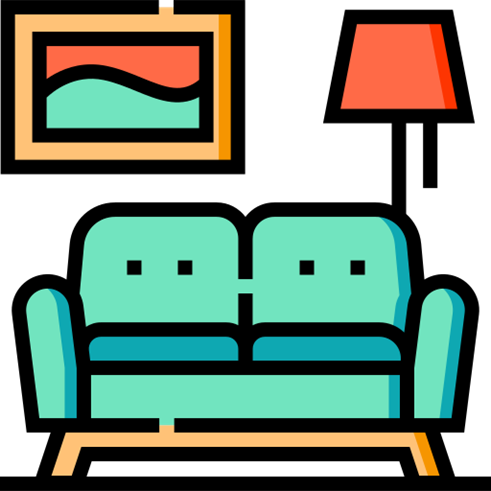Home Environment
Click a link for more information:
Discussion Questions Sensory Stimulation Activities
To improve a person living with dementia's quality of life and well-being, it is important to adapt their home to be as safe and comfortable as possible. This allows them to have more independence for longer, which is vital when it comes to improving a person's self-worth.
Lighting in the home:

For most people living with dementia, they will benefit from having better lighting in the home. This is because it can help areas and items to be seen clearly, can help with moving around/way finding and reduce shadows, which all contribute to reducing the risk of falls.
To increase natural lighting:
- Make sure the curtains are open when it is daylight and closed when it is dark
- Ensure the windows are clean
- Make sure nothing is blocking the windows.
- Have the hedges and trees cut back so that natural light can come in
Lighting is particularly important near stairs and in the toilet area/bathroom. Ensure that the highest possible wattage of light bulb is used with a shade which optimises the flow of light. Also, make sure light switches are easily seen by highlighting them with coloured tape around the edges.
A good addition to the home could be automatic light switches, timer lighter or sensor lights which are activated by movement. Just ensure that these don’t startle a person or cause them to feel anxious.
Safe flooring:
- Always make sure that any spillages, leaks, puddles are cleared up as soon as possible.
- Ensure any loose carpets are secured to reduce the hazard.
- Avoid using rugs or mats on the floor as these can be trip hazards and someone living with dementia may get confused thinking they are an object that they have to step over or a hole, which can lead to falls.
- Avoiding shiny or reflective floors to minimise the chances of someone perceiving this as being wet and therefore making them struggle to walk over it.
- Try avoiding coloured floors too, such as green, this can be mistaken as grass or blue can be seen as water.
The most suitable flooring is secure and matt effect flooring that contrasts with the colour of the walls.
Rearranging furniture:

Sometimes furniture can be helpful as people use this to help with orientation and also support. However, reaching for and leaning on furniture should not be encouraged.
Furniture can also be a hazard if it obstructs movement around a room/home. Consider:
- pushing a coffee table next to a wall if it is in the middle of a room so that it creates a clear pathway.
- Making a clear pathway through furniture, eg, having big gaps in between sofas if they are pushed close together, to make it easily accessible to get through, especially if a person is using a walking aid.
Reaching for items in the home
Think about things that are on the floor which may need picking up. Leaning over to reach for an item can cause a person to over reach or result in dizziness which increases a persons risk of fall.
If a person is using a walking stick, this could easily fall on the floor. Consider propping it against the furniture close by where the person is sitting or using a walking stick tabletop grip which is an accessory that can be used with most walking sticks to affix to the edge of a table or worktop enabling the walking stick to be balanced upright. Wearing a wrist strap around a walking stick can also help to stop the stick falling to the floor, free a persons hands and prompt them to remember to use it.
Easy reaches can be useful for picking things up that are out of reach.
A letter box cage attached to the back of the door to catch the post can be useful but make sure that it does not obstruct the opening of the door.